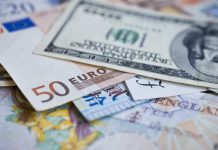Pound traders finally got some much-needed relief on Thursday. Throughout yesterday, the pound gained steadily versus the dollar, reaching a high of 1.3559 at noon, and then remaining more or less steady throughout the trading session. Early trends from today continue to show growth in the value of pound versus the US dollar.
| What do these figures mean? |
|---|
|
When measuring the value of a pair of currencies, one set equals 1 unit and the other shows the current equivalent. As the market moves, the amount will vary from minute to minute. For example, it could be written: 1 GBP = 1.28934 USD Here, £1 is equivalent to approximately $1.29. This specifically measures the pound’s worth against the dollar. If the US dollar amount increases in this pairing, it’s positive for the pound. Or, if you were looking at it the other way around: 1 USD = 0.77786 GBP In this example, $1 is equivalent to approximately £0.78. This measures the US dollar’s worth versus the British pound. If the sterling number gets larger, it’s good news for the dollar. |
UK’s service sector PMI, or Purchasing Manager’s Index, produced by a data firm called Markit, has jumped to 54.2 for last month, from 53.8 in November suggesting that the UK economy is doing very well. PMI measures the health of a sector by surveying purchasing managers working in that sector. It’s usually a reliable indicator of health of an economy — a reading over 50 shows growth. This is the second-highest score for UK since last April and, a result, pound rallied.
Apart from PMI, UK mortgage approvals also rose unexpectedly in November, according to the data released by the Bank of England on Thursday. The total number of mortgages approved for purchasing house rose to 65,139 in November compared to 64,887 in October. Analysts initially forecasted approvals to fall to 64,000. However, the data beat the expectations and as a result, traders regained faith in sterling strength.
| Why does strong economic data boost a country’s currency? |
|---|
| Solid economic indicators point to a strong economy. Strong economies have strong currencies because institutions look to invest in countries where growth prospects are high. These institutions require local currency to invest in the country, thus increasing demand and pushing up the money’s worth. So, when a country or region has good economic news, the value of the currency tends to rise. |
Despite US Economic Gains, Investors Still Leary of Dollar
The pound gained despite several good developments concerning the US economy. Firstly, the US stock market reached a record all-time high yesterday during the beginning of trading session. Secondly, payroll firm ADP released its latest job report showing that the US private sector created many more jobs than expected last month. Suggesting that the US economy is robust. The report stated that US companies hired 250,000 new workers in December, with most of these hires made by service sector companies. Economists had only expected a rise of 190,000 new jobs. However, analysts were unhappy that the same report also showed no growth in wages for US workers.
A more important report on US jobs growth is expected to be released today. Investors are going to keep a close watch at the US non-farm payroll figures today. If, like today’s report, the data is better than expected, the dollar might rally versus the pound. In a more long-term view, traders will also keep an eye on data regarding consumer credit growth in the UK. Yesterday’s report suggest that consumer credit growth in UK has slowed, which is usually a bad sign for the economy. Should this trend continue, the pound might weaken.
| How does the non-farm payroll (NFP) affect the US dollar? |
|---|
| It works like this, when there is low unemployment and high job creation, the demand for workers increases. As demand for workers goes up, wages for those workers also go up. Which means the workers are now taking home more money to spend on cars, houses or in the shops. As a result, demand for goods and services also increase, pushing the prices of the good and services higher. That’s also known as inflation. When inflation moves higher, central banks are more likely to raise interest rates, which then pushes up the currency’s worth. |
|
This article was initially published on TransferWise.com from the same author. The content at Currency Live is the sole opinion of the authors and in no way reflects the views of TransferWise Inc. |





